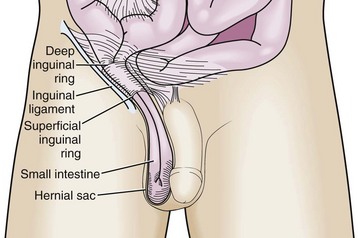All of us who take our workouts seriously, especially men, sometimes experience a pinching or a burning sensation in the groin area. (The groin is that portion of the anatomy between abdomen and thigh). Many have a tendency to ignore this sensation; however, you should be aware that this may be a significant symptom warning of inguinal hernia development. With an inguinal hernia, the contents of the abdominal cavity (e.g. intestine) may protrude into one of the inguinal canals. The inguinal canals are two passages in the front abdominal wall. In men, they carry the spermatic chords, and they contain uteral ligaments in women. Inguinal hernia is a serious medical condition. Treatment and complications resulting from the treatment can lead to prolonged periods of inactivity. Complete abstinence from that strenuous physical activity required for maintaining good physical and mental health is often necessary. That is an important reason why athletes avoid inguinal hernia.
First of all, there are two primary types of inguinal hernia which can develop: indirect or direct. In an indirect inguinal hernia, a portion of bowel migrates into the canal after first penetrating the deep inguinal ring located at its entrance. In men, migration may advance as far as the scrotal sack. Indirect inguinal hernia is illustrated below:
Indirect inguinal hernia
In a direct hernia, protuberance takes place through a weakened portion of abdominal wall. This is likewise illustrated below:
Direct inguinal hernia
Surgery is often recommended and performed in the event either hernia type occurs. Such surgery is usually performed nowadays on an outpatient basis and is commonly billed by its practitioners as a simple “straightforward” procedure. Nevertheless, serious complications do occur and there is always a risk of hernia recurrence following the surgery. Just what are today’s hernia surgery complication and recurrence rates? In investigating that important question, Spanking FIT uncovered: “Risk factors and outcomes of acute versus elective groin hernia surgery” by Y. Abi-Haidar et al. published in Journal of the American College of Surgery, Sept. 2011;213 (3): 363-9. While the main purpose of this study, as the title implies, was to compare risks between two different hernia conditions, alarming statistics regarding surgery complication and recurrence rates were also disclosed by it. Researchers conducted a retrospective (looking backwards in time) study of 1,034 consecutive groin hernia repair cases performed from 2,001 to 2,009 within the Boston Veterans Administration (V.A.) Health Care System. They reported that among the 971 patients who underwent elective hernia repair, the recurrence rate was approximately 17%. Among 63 acute repair patients, it was even higher- over 30%. They also reported hernia surgery complications occurring in about 15% and 27% of elective and acute repair patients respectively. While the results of a consecutive case series study such as this one may not necessarily be representative of the population-at-large, they should still serve as a note of caution to anyone who takes the warning signs of inguinal hernia lightly. The nature of complications following hernia surgery have been reported extensively throughout the years in the medical literature. They include urinary retention, bladder injury, wound/mesh infection and rejection, persistent pain in the groin, testicular complications, etc. A good summary of complications was presented by D. Brooks, M.D. in “Overview of complications of inguinal and femoral hernia repair” published in uptodate.com, Wolters Kluwer. All are of a serious nature and can lead easily to dreaded prolonged physical inactivity. It should be clear that one needs to do whatever it takes to, if possible, to prevent this condition from occurring in the first place.
It’s also important to note that congenital factors may play a role for indirect hernia risk in particular. Nevertheless, exercises such as Yoga crunches which strengthen specifically abdominal muscle can be valuable for preventing both indirect and direct hernia (see: “Science and Six-Pack-Abs”, Spanking FIT, Jan., 2017). Strenuous weight-lifting activities and even aerobic ones such as walking or jogging can, over time, stress and weaken the inguinal region. For this reason, the latter activities need to be balanced out with a hernia prevention regiment. Spanking FIT recommends that the following three exercise routine be performed on a regular basis:
Athletes avoid inguinal hernia- 3 suggested exercises for avoiding the surgeon’s knife
(1) Lie on your back, either in bed or on a softly carpeted floor. Pull your hips and legs up and over your chest using your hands. Hold this position for several seconds. Slowly return to the original prone position.
(2) Again, while lying down comfortably, point your left foot straight up towards the ceiling so that your leg is vertical. Pull a towel wrapped around the back of the sole of your foot towards your chest with both hands and without moving the leg. Let the leg act as resistance. Repeat with the right leg as illustrated below: 
(3) The exercise that works wonders for inguinal strain in helping to avoid the surgeon’s knife is hanging upside down for a period of time. This, of course, requires additional apparatus in order to be safely performed.
I hope that you have found this segment on “Athletes Avoid Inguinal Hernia” informative and useful. Please don’t forget to give us your feedback. For additional exercise routines intended to strengthen the anatomy and prevent injury you may wish to consult Spanking FIT’s “Healthy Body Art Series” beginning with how to acquire Venus Dimples of the Lower Back. Thanks again. Dr. Garrett
Photo credit:
Creative commons license: https://creativecommons.org/licenses/by-nc/2.0/



